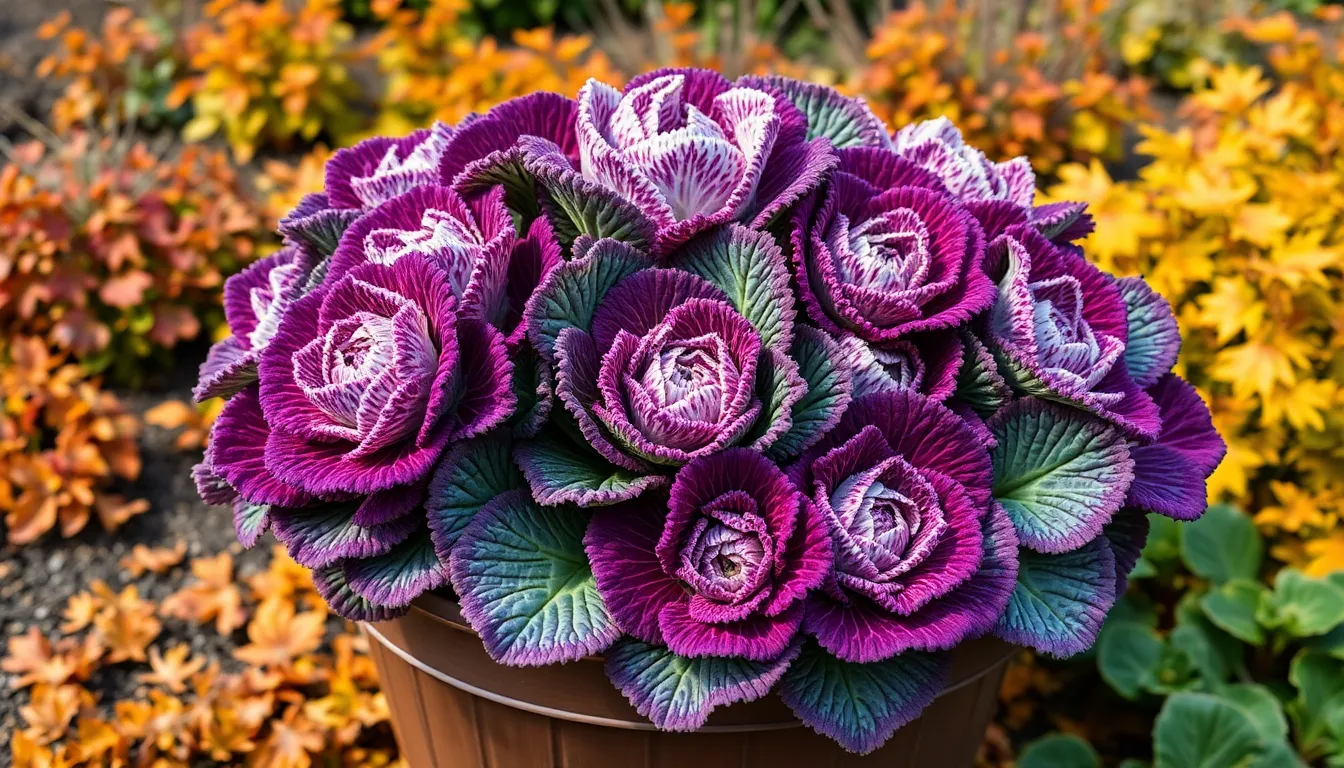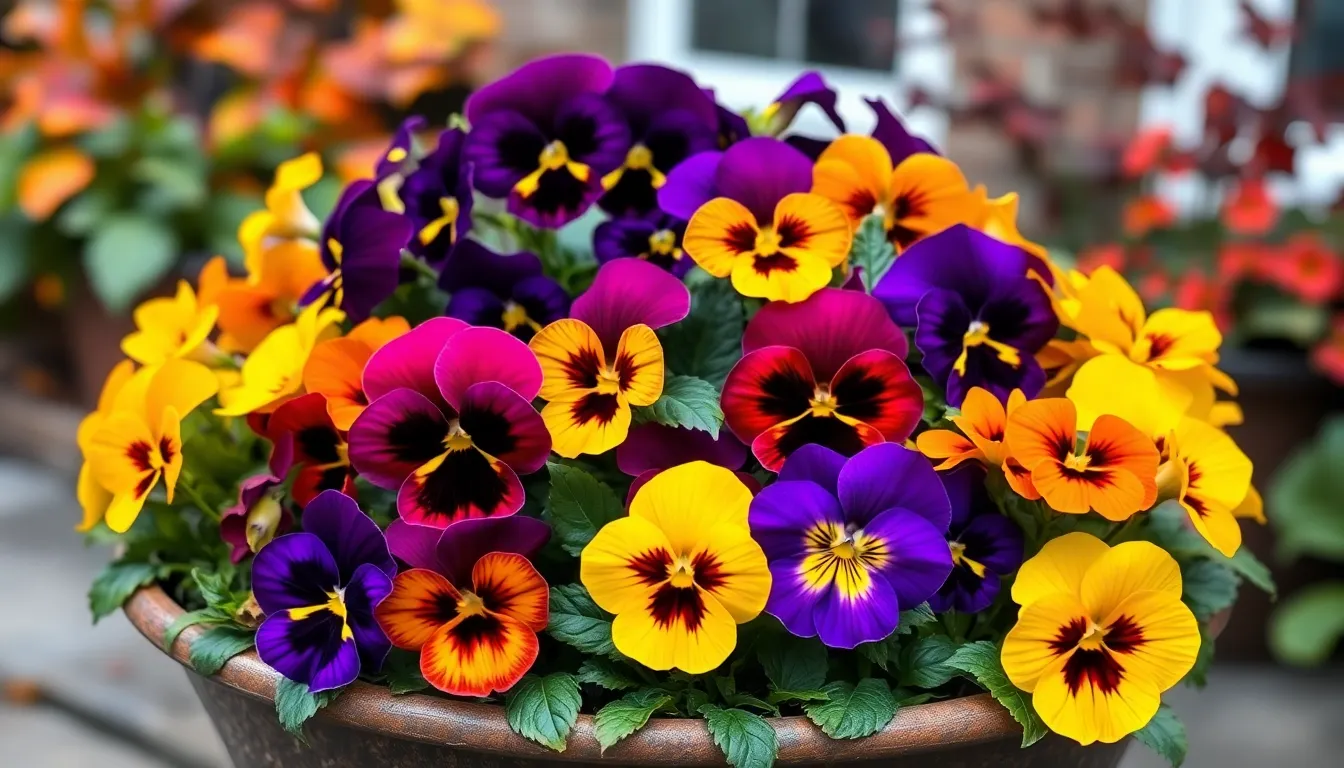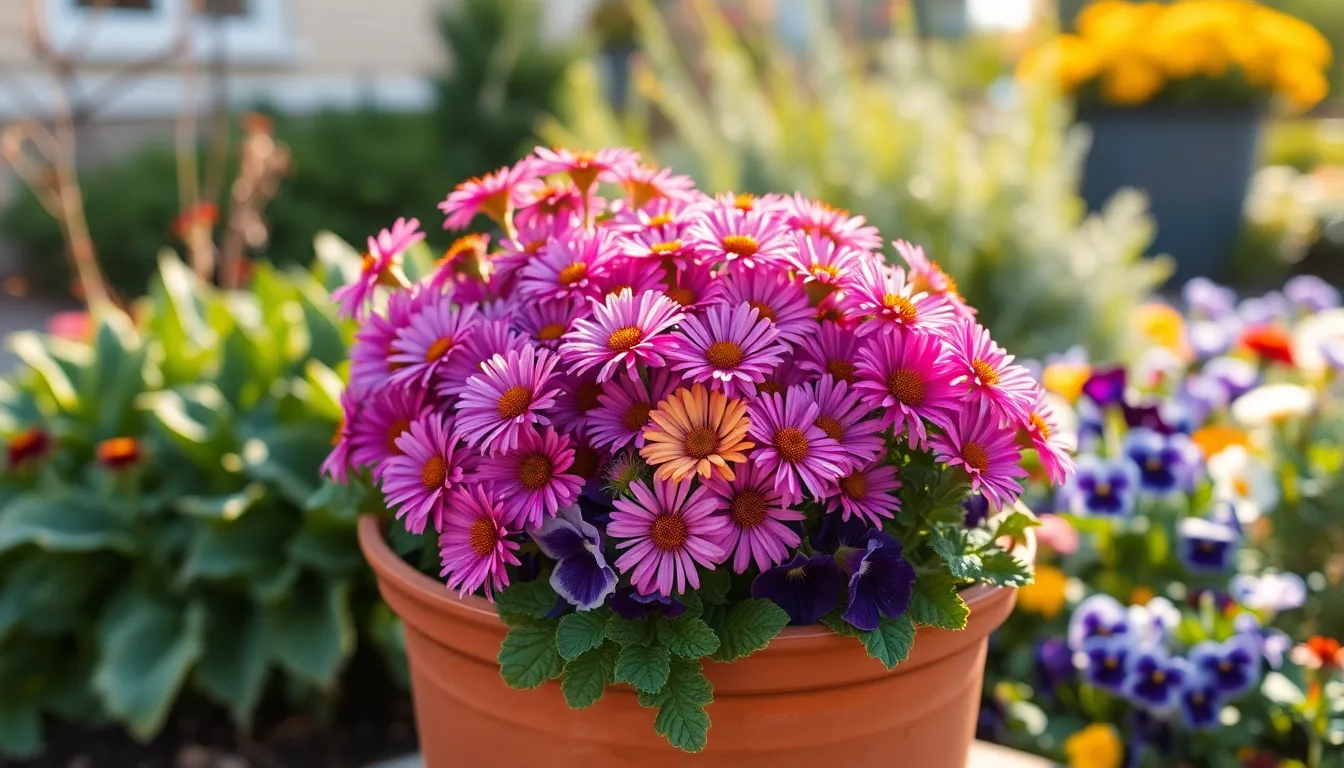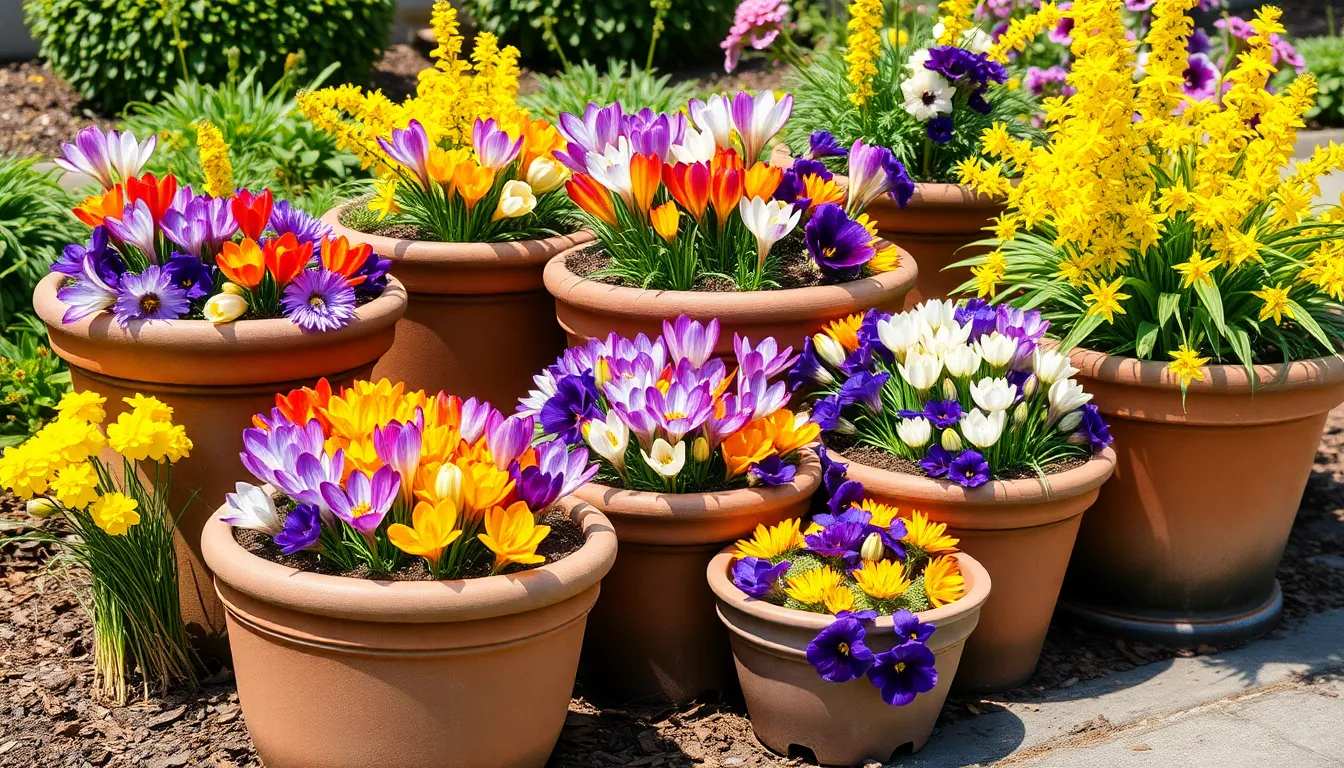As autumn’s crisp air settles in we find ourselves yearning to bring seasonal beauty to our outdoor spaces. Fall container gardening offers the perfect solution for extending our growing season while creating stunning displays that celebrate autumn’s rich palette of colors and textures.
We’ve discovered that potted fall plants provide incredible versatility – allowing us to create portable gardens that can be moved to shelter when harsh weather arrives. From vibrant chrysanthemums and ornamental kale to trailing ivy and colorful pansies these autumn champions thrive in containers while delivering months of visual impact.
The best part? Fall gardening in pots requires minimal space and maintenance making it ideal for apartment dwellers busy homeowners and anyone looking to add instant curb appeal. Whether you’re decorating a front porch creating a cozy patio retreat or simply wanting to enjoy autumn’s beauty up close we’ll show you exactly which plants deliver the biggest seasonal impact in containers.
Choose Hardy Mums for Vibrant Fall Color
Chrysanthemums stand as the quintessential fall flower, delivering exceptional color when many other plants begin to fade. These resilient blooms thrive in cooler autumn temperatures and provide weeks of continuous flowering in container gardens.
Select Compact Varieties for Container Growing
Cushion mums work perfectly for pot displays since they naturally grow in rounded, compact shapes reaching only 12-18 inches tall and wide. These varieties include ‘Autumn Fire’ with its bronze-red petals and ‘Bolero’ featuring deep burgundy blooms that resist wind damage.
Decorative mums offer fuller flower heads while maintaining manageable sizes of 15-20 inches, making them ideal centerpieces for larger containers. Popular choices like ‘Matchstick Yellow’ produce hundreds of small daisy-like flowers, while ‘Igloo White’ creates dense clusters of pristine white blooms.
Garden mums specifically bred for outdoor conditions handle temperature fluctuations better than florist varieties and return year after year in USDA zones 5-9. Varieties such as ‘Mammoth Purple’ and ‘Clara Curtis’ establish strong root systems that overwinter successfully in containers with proper protection.
Pick Colors That Complement Your Outdoor Space
Warm autumn tones like deep orange, russet red, and golden yellow create classic fall displays that pair beautifully with ornamental gourds and seasonal decorations. Varieties including ‘Autumn Spice’ and ‘Bolero Bronze’ enhance existing industry elements like brick walkways or wooden decking.
Rich burgundy and purple shades provide sophisticated contrast against evergreen backdrops and complement late-season foliage plants. Cultivars such as ‘Mammoth Purple’ and ‘Matchstick Wine’ create dramatic focal points when planted alongside silver-leaved plants like dusty miller.
Bright white and cream varieties illuminate shaded areas and create elegant monochromatic schemes when combined with white pumpkins or silvery ornamental cabbage. Options like ‘Igloo White’ and ‘White Favor’ brighten north-facing porches and entryways that receive limited sunlight during shorter fall days.
Plant Ornamental Kale for Striking Foliage

Ornamental kale transforms ordinary fall containers into spectacular displays with its decorative foliage. These Brassica oleracea varieties offer stunning visual appeal that lasts throughout the autumn season.
Choose Purple and White Varieties for Visual Interest
Purple varieties like Brassica oleracea ‘Redbor’ create dramatic focal points with their deep red leaves that intensify as temperatures cool. White ornamental kale such as B. oleracea ‘Emperor Rose’ provides elegant contrast when paired with darker companions in your fall pot arrangements.
Rich purple and crisp white combinations deliver the strongest visual impact for container gardens. These contrasting colors enhance the overall aesthetic while maintaining sophisticated appeal that complements traditional autumn decorating schemes.
Selecting varieties with ruffled or frilled edges adds textural interest beyond basic color combinations. Deep burgundy centers surrounded by cream or white outer leaves create natural gradients that draw the eye upward in taller container displays.
Ensure Proper Drainage for Healthy Growth
Proper drainage prevents waterlogging that damages roots during fall’s cooler and wetter conditions. We recommend adding drainage holes to containers that lack adequate water flow capabilities.
Layer gravel or broken pottery shards in the bottom of pots before adding potting mix to improve water movement. This technique allows excess moisture to escape while maintaining the soil structure ornamental kale needs for optimal growth.
Well draining soil keeps roots healthy as autumn progresses into winter months. Waterlogged conditions reduce the plants’ ability to thrive and can cause the striking foliage colors to fade prematurely.
Monitor soil moisture levels regularly since ornamental kale prefers consistently moist but not soggy growing conditions. Proper drainage systems allow you to water confidently without risking root rot or other moisture related problems.
Add Pansies for Cool Weather Blooms

Pansies bring vibrant colors and exceptional cold tolerance to our fall container gardens. These classic flowers thrive in cool weather conditions when many other plants begin to fade.
Select Heat-Tolerant Varieties for Extended Seasons
Heat-tolerant pansy varieties extend our growing season well into the warmer fall days. We recommend choosing cultivars specifically bred for temperature fluctuations like ‘Cool Wave’ and ‘Matrix’ series. These varieties maintain their blooms even when temperatures swing between warm afternoons and cool evenings.
Modern pansy breeding has created plants that perform better in transitional weather. We’ve found that heat-tolerant varieties continue flowering through October and November in most regions. Look for pansies labeled as “heat tolerant” or “extended season” at garden centers.
Container growing provides additional protection for heat-sensitive varieties. We can move pots to shadier locations during unexpectedly warm days. This flexibility allows us to grow both standard and heat-tolerant pansies successfully.
Combine Colors for Eye-Catching Arrangements
Color combinations create stunning visual impact in our fall pansy displays. We suggest pairing deep purple pansies with bright yellow varieties for classic autumn contrast. Orange and burgundy pansies complement the seasonal palette perfectly.
White pansies brighten darker color schemes and provide elegant focal points. We often use cream or light yellow varieties to bridge bold color combinations. These lighter shades prevent arrangements from appearing too heavy or overwhelming.
Pattern mixing adds sophisticated dimension to our pansy containers. We combine solid colored varieties with bi-colored or faced pansies for textural interest. Whisker-marked varieties like ‘Tiger Eye’ create playful accents when paired with solid companions.
Monochromatic schemes offer refined elegance in fall displays. We create depth using different shades of the same color family. Purple pansies in lavender, violet, and deep plum create sophisticated gradations that complement autumn foliage.
Include Ornamental Cabbage for Textural Interest

Ornamental cabbage brings robust, colorful foliage that transforms fall containers with its sculptural presence. These hardy plants thrive in cooler weather and provide the crisp textural element your autumn displays need.
Choose Large Varieties as Focal Points
Large ornamental cabbage varieties serve as striking centerpieces that anchor your fall container designs. We recommend selecting specimens with substantial leaf structures that naturally draw the eye and create visual weight in your arrangements. Swiss chard with orange or yellow stems makes an excellent alternative focal point, offering vibrant color while filling generous space in larger pots.
These substantial plants establish the foundation for your entire composition. Bold varieties with wide, ruffled leaves command attention and provide the structural backbone your containers require. We’ve found that positioning one large ornamental cabbage slightly off center creates more ever-changing visual interest than perfect symmetry.
Premium varieties like ‘Redbor’ kale deliver dramatic purple foliage that serves as an ideal focal element. Combining large ornamental cabbage with equally substantial Swiss chard creates layered focal points without overwhelming smaller containers. Your choice of large varieties should complement the container size while leaving adequate space for supporting plants.
Pair with Trailing Plants for Layered Looks
Trailing plants soften the edges of ornamental cabbage while adding flowing dimension to your fall arrangements. We pair these cascading elements with our focal plants to create rich, textured displays that capture the eye from multiple angles. Popular trailing selections include ivy, creeping Jenny, and certain violas that complement the robust structure of ornamental cabbage.
These flowing plants create natural transitions between your container’s rim and the surrounding industry. Trailing elements add movement and grace to otherwise static arrangements, preventing your displays from appearing too rigid or formal. We strategically position trailing plants around the perimeter to frame our central ornamental cabbage and enhance the overall composition.
Layering with trailing plants enriches visual complexity and makes planters appear more lush and established. The contrast between upright ornamental cabbage and cascading companions creates ever-changing interplay that holds interest throughout the season. Multiple trailing varieties can work together, with some spilling over container edges while others weave between larger plants for integrated texture.
Incorporate Fall-Blooming Asters for Late Season Color

Fall-blooming asters bring vibrant shades to our containers just when many other plants begin to fade. These cheerful flowers provide the perfect solution for maintaining colorful displays through autumn’s cooler months.
Select Dwarf Varieties Suitable for Containers
Choosing compact aster varieties ensures our potted displays remain proportionate and manageable throughout the growing season. Dwarf asters adapt exceptionally well to the limited root space that containers provide, preventing overcrowding issues that can plague larger varieties.
Standard-sized asters often become too tall and top-heavy for pot cultivation, making dwarf selections the smarter choice for stable, attractive arrangements. Companion plants like ornamental kale, coral bells, pansies, and chrysanthemums work beautifully alongside compact asters in mixed container displays.
Container gardening success depends heavily on selecting plants that won’t outgrow their space, and dwarf asters deliver consistent performance without requiring frequent repotting. These smaller varieties maintain their shape better than full-sized alternatives, creating neater displays that last longer.
Provide Adequate Sunlight for Best Flowering
Positioning our aster containers in locations that receive at least 4-6 hours of direct sunlight daily promotes the healthiest growth and most abundant blooms. Most fall-blooming plants, including asters, chrysanthemums, and pansies, thrive in full sun to partial sun conditions.
Insufficient light leads to weak, leggy growth and disappointing flower production in our fall container gardens. Strategic placement near south-facing walls or in open areas maximizes light exposure during shorter autumn days.
Moving containers throughout the day can help optimize sun exposure, especially as the angle of sunlight changes with the season. Morning sun proves particularly beneficial for fall bloomers, as it helps dry dew from foliage and reduces disease risks in cooler weather.
Plant Sedum for Low-Maintenance Fall Interest

Sedum varieties provide exceptional structure and resilience to fall container displays. These succulent plants maintain their visual appeal throughout the season while requiring minimal attention from busy gardeners.
Choose Upright Varieties for Height Variation
Upright sedum cultivars create dramatic vertical elements that transform flat container arrangements into ever-changing displays. Varieties like ‘Autumn Joy’ reach 18-24 inches tall and produce stunning pink flower clusters that deepen to copper-red as temperatures drop. Tall sedums anchor arrangements effectively when positioned toward the back or center of larger containers.
‘Matrona’ offers another excellent upright option with burgundy stems and gray-green foliage that complements fall color schemes perfectly. This variety grows 24-30 inches high and produces dense flower heads that attract beneficial pollinators during late season blooms. Combining multiple upright varieties creates layered heights that add visual depth to our container gardens.
Select Drought-Tolerant Species for Easy Care
Drought-tolerant sedum species thrive in containers without frequent watering schedules that other fall plants demand. ‘Dragon’s Blood’ sedum forms low-spreading mats with burgundy foliage that intensifies in cooler weather, requiring water only when soil becomes completely dry. This hardy variety tolerates neglect while providing consistent color throughout autumn months.
‘Angelina’ sedum displays bright chartreuse foliage that transitions to orange and red tones as fall progresses. Its trailing habit works beautifully along container edges while its succulent leaves store water efficiently during dry periods. These drought-adapted varieties survive temperature fluctuations and irregular watering better than traditional fall annuals, making them ideal choices for gardeners seeking reliable container plants that maintain their beauty with minimal intervention.
Add Heuchera for Year-Round Foliage Appeal

Heuchera brings exceptional foliage interest to fall containers while maintaining visual appeal throughout winter months. We recommend coral bells as a versatile perennial that offers evergreen leaves in stunning color combinations year after year.
Select Colorful Leaf Varieties for Seasonal Interest
Choose from Heuchera’s extensive color palette to create striking seasonal displays in your fall containers. Deep purple varieties like ‘Plum Pudding’ provide robust structure and retain their rich coloration throughout cooler months. Vibrant red cultivars add warmth to autumn arrangements while bright green options offer fresh contrast against darker fall companions.
Silver and copper toned varieties create sophisticated displays that complement ornamental kale and chrysanthemums beautifully. Orange leafed selections echo autumn’s natural color scheme while providing texture through their distinctively ruffled edges. Modern Heuchera hybrids showcase intricate patterns and veining that become more pronounced as temperatures drop.
We’ve found that these colorful leaf varieties maintain their visual impact even when other plants begin to fade. Selecting multiple color combinations allows you to create layered arrangements that evolve throughout the season. Consider pairing lighter foliage varieties with your existing pansies and darker specimens alongside ornamental cabbage for balanced compositions.
Ensure Partial Shade Placement for Optimal Growth
Position your Heuchera containers in partial shade locations to prevent leaf scorch and maintain vibrant coloration. Lighter foliage varieties particularly benefit from increased shade protection while darker leafed types can tolerate slightly more sun exposure. We recommend avoiding full sun placement as it can cause color fading and stress during warmer fall days.
Partial shade conditions help these evergreen perennials thrive in container environments while supporting their natural growth patterns. Strategic placement near structures or under tree cover provides the ideal growing conditions that coral bells prefer. This positioning also protects containers from harsh afternoon sun that can damage delicate leaf surfaces.
Well drained soil remains essential regardless of light conditions since Heuchera’s root systems are susceptible to waterlogging. We suggest using quality potting mix and ensuring adequate drainage holes in your containers. These low maintenance plants resist most pests and diseases when grown in proper conditions, making them reliable choices for busy gardeners seeking year round appeal.
Include Ornamental Peppers for Colorful Fruit Display

Ornamental peppers bring vibrant hues and unique texture to our fall container gardens when other plants start to fade. These stunning plants offer a colorful fruit display that enhances visual interest in autumn-themed pots while providing season-long beauty.
Choose Compact Varieties Perfect for Small Pots
Compact ornamental pepper varieties fit perfectly in small containers without overwhelming our arrangements. Miniature pepper plants create a full, lush appearance while maintaining proper proportion in limited pot space. These dwarf varieties prevent overcrowding issues that commonly occur with larger pepper plants in containers.
We recommend selecting pepper cultivars specifically bred for container growing to ensure optimal performance. Dense growth patterns in compact varieties provide maximum visual impact without requiring excessive space. Small ornamental peppers complement other fall favorites like chrysanthemums and ornamental kale beautifully in mixed arrangements.
Container-friendly pepper plants maintain their shape throughout the season while producing abundant colorful fruits. These varieties typically reach heights of 12-18 inches, making them ideal for tabletop displays and small patio containers.
Provide Full Sun for Best Fruit Production
Full sun exposure maximizes fruit production and promotes the most vibrant colors in our ornamental pepper displays. We need to provide at least 6 hours of direct sunlight daily to ensure healthy plant development and abundant fruiting. Strategic placement of pepper containers in the sunniest areas of our outdoor spaces delivers the best results.
Adequate sunlight encourages dense fruit clusters that create the stunning visual displays we desire in fall arrangements. Morning sun exposure particularly benefits ornamental peppers by reducing disease risks while promoting strong growth patterns. Southern or western-facing locations typically provide the intense light these plants require for optimal performance.
Insufficient light leads to sparse fruiting and less vibrant colors, diminishing the overall impact of our fall container gardens. We can easily move pepper containers throughout the day to follow the sun and maximize light exposure when needed.
Plant Fall-Blooming Crocus for Early Season Interest

Fall-blooming crocus varieties like Colchicum species offer unique early autumn color when most other plants begin to fade. We can plant these bulbs in pots to create distinctive seasonal displays that bridge the gap between summer and peak fall blooms.
Select Varieties That Naturalize in Containers
Colchicum species thrive in container environments and naturally establish themselves for recurring displays. We recommend these fall-blooming bulbs because they adapt well to pot restrictions while providing reliable autumn color year after year.
Companion plants like asters and pansies create layered container displays that complement fall crocus blooms. These varieties naturalize effectively in pots, meaning they’ll return or spread in subsequent seasons when conditions allow.
Chrysanthemums and snapdragons pair beautifully with fall crocus for extended seasonal interest. We’ve found these combinations work especially well because all varieties prefer cooler temperatures and similar growing conditions.
Goldenrod (Solidago) adds bright yellow contrast to fall crocus displays while attracting beneficial pollinators. Container growing helps control this herbaceous perennial’s somewhat invasive nature, making it an ideal companion for potted fall gardens.
Plant Bulbs at Proper Depth for Spring Returns
Proper planting depth ensures successful spring blooms from fall-planted bulbs in containers. We plant bulbs at two to three times their height to provide adequate root development and cold protection.
Spring-flowering bulbs like crocus and tulips require exact depth placement when container-planted in fall. Measuring each bulb’s height and multiplying by three gives us the ideal planting depth for optimal spring performance.
Well-draining potting mix prevents bulb rot during winter months while maintaining proper moisture levels. We add gravel or broken pottery shards to container bottoms to improve drainage and protect bulbs from waterlogging.
Container placement affects bulb development throughout winter dormancy periods. We position fall-planted bulb containers in protected areas that receive adequate winter chill hours while avoiding extreme temperature fluctuations.
Conclusion
Creating stunning fall container gardens opens up endless possibilities for transforming our outdoor spaces during autumn’s peak season. We’ve explored how the right combination of hardy plants like chrysanthemums ornamental kale pansies and asters can deliver months of vibrant color and texture.
The beauty of container gardening lies in its flexibility – we can experiment with different plant combinations adjust placement for optimal growing conditions and easily protect our investments when harsh weather arrives. Whether we’re working with a small balcony or expansive patio these portable gardens let us enjoy autumn’s splendor wherever we are.
With proper plant selection adequate drainage and strategic positioning we can create fall displays that rival any traditional garden bed. Our container gardens will continue rewarding us with seasonal beauty while requiring minimal maintenance throughout the autumn months.
Frequently Asked Questions
What are the best plants for fall container gardening?
The best plants for fall containers include hardy chrysanthemums, ornamental kale and cabbage, pansies, fall-blooming asters, and trailing plants like ivy. These plants offer vibrant colors, cold tolerance, and seasonal appeal. Chrysanthemums provide classic fall blooms, while ornamental kale adds striking foliage. Pansies offer exceptional cold tolerance, and asters maintain color as other plants fade.
Why are chrysanthemums recommended for fall containers?
Chrysanthemums are ideal for fall containers because they’re hardy, offer vibrant autumn colors, and thrive in cooler temperatures. Compact varieties like cushion mums are perfect for containers, while decorative mums provide fuller flower heads. Garden mums bred for outdoor conditions can return year after year, making them a reliable choice for seasonal displays.
How do I create visual interest in fall container arrangements?
Create visual interest by combining different plant heights, textures, and colors. Use large plants like ornamental cabbage as focal points positioned slightly off-center. Add trailing plants like ivy or creeping Jenny to soften edges and create movement. Mix warm autumn tones with rich burgundy or purple for sophisticated contrast, or use bright white varieties to illuminate shaded areas.
What colors work best for fall container gardens?
Warm autumn tones like orange, yellow, and red create classic fall displays. Rich burgundy and deep purple provide sophisticated contrast, while bright white and cream varieties illuminate shaded areas. You can pair deep purple pansies with bright yellow for eye-catching combinations, or use monochromatic schemes for refined elegance.
How do I ensure proper drainage in fall containers?
Ensure proper drainage by adding gravel or broken pottery shards to the bottom of containers before adding soil. Use well-draining potting mix to prevent waterlogging, which is especially important for plants like ornamental kale and fall-planted bulbs. Regular monitoring of soil moisture levels helps maintain optimal growing conditions throughout the season.
Can apartment residents successfully do fall container gardening?
Yes, fall container gardening is perfect for apartment residents because it requires minimal space and maintenance. Containers can be easily moved to protect plants from harsh weather or to optimize sunlight exposure. This flexibility makes it ideal for balconies, patios, or small outdoor spaces where traditional gardening isn’t possible.
When should I plant fall-blooming bulbs in containers?
Plant fall-blooming bulbs like Colchicum crocus in late summer for autumn displays. For spring-blooming bulbs planted in fall, ensure proper planting depth of two to three times the bulb’s height. Use well-draining potting mix and place containers strategically to protect bulbs during winter dormancy while ensuring they receive adequate cold exposure for spring blooming.
How much sunlight do fall container plants need?
Most fall container plants, especially asters and chrysanthemums, need at least 4-6 hours of direct sunlight daily for optimal flowering. Morning sun is particularly beneficial as it reduces disease risks in cooler weather. Strategic placement of containers to maximize light exposure helps promote healthy growth and abundant blooms throughout the fall season.







